![]()
![]()
![]()
Use LEFT and RIGHT arrow keys to navigate between flashcards;
Use UP and DOWN arrow keys to flip the card;
H to show hint;
A reads text to speech;
326 Cards in this Set
- Front
- Back
- 3rd side (hint)
|
EMS |
Consists of a team of heath care professionals who administer aid to a person at home or in the street, through the time they are discharged |
Emergency Medical Service |
|
|
Levels of the Emt |
Cfr : certified first responder EMT B : BASIC Emt-I: intermediate Emt-CC : Critical care EMT - P : paramedic |
Cfr, emtB, emt i, etc.... |
|
|
Components of the EMS System |
Buses - either bls or Als Equipment Dispatched Emts |
Only the First 4 components |
|
|
Medical Director (MD) |
The physician who authorizes or delegated to the Emt the authority to provide medical care in the field. |
Other components of EMS system |
|
|
Quality Control |
The responsibility of the medical director to ensure that the appropriate medical care standards are met by the EMT-b's on each call |
Components of the EMS system - ensure .......medical care |
|
|
Rules & Responsibilities |
1) Drive to the patient safely 2)Have directions and know how to get to location 3) Patient care 4) patient packaging 5) look & Act professional |
Referring to Emt |
|
|
On-line Direction |
On the phone with MD |
Medical Direction |
|
|
Off-line Direction |
Pre-written or standing orders (protocols) |
Medical direction |
|
|
Definitive signs of Death |
1.) Obvious Mortal Injury 2.) Rigor Mortis 3.) Dependant lividity 4.) Purification |
4 signs |
|
|
Obvious Mortal Injury |
Decapitation e.i |
|
|
|
Rigor Mortis (RM) |
Stiffness occurs within 2 to 12 hours after death |
|
|
|
Dependant lividity |
Blood settling to the lowest point of the body,causing discoloration of the skin. |
|
|
|
Purification |
Decomposition of body tissue. Occurs between 40 to 96hrs after death |
|
|
|
Do not Resuscitate or a Molst |
Other times when a emt doesn't do cpr is in the case if a do not resuscitate order or a molst , which is a Medical Orders for Life Sustaining Treatment |
DNR |
|
|
Stages of Grieving Process |
1. Denial 2. Anger 3. Bargaining 4. Depression 5. Acceptance |
5 stages |
|
|
Dealing with Dying Patients |
1. Maintain patient dignity 2. Show respect for your patient 3. Communicate with the family 4. allow family members to Express themselves 5.Do not give false assurances 6. Listen to the family 7. Use a gentle tone of voice |
7 things to do |
|
|
Stress warning signs |
1. Irritability 2. Unable to concentrate 3. anxiety 4.lost of appetite or over eating 5.loss of interest in work, sex, etc 6.Isolation 7.Increase alcohol use |
|
|
|
Dealing with Stress /CISD |
Critical Incident Stress Debriefing - Program in which severely stressful job related incidents are discussed. These meeting are held within 24 to 72 hours after an incident. |
|
|
|
Standard of care |
The way another equally trained person would act to treat a patient |
Medical/legal/Ethical |
|
|
Scope of Practice |
The skills you are allowed to use |
|
|
|
Duty to Act |
An emt has a duty to act only when in uniform or on duty. |
|
|
|
Public Law 800 |
Emt cannot be held liable useless gross negligence is proven. |
|
|
|
Good samaritan law |
Does not cover EMT's in New York State |
|
|
|
Negligence |
Failure to provide same level of care as another equally trained emt |
|
|
|
Abandonment |
Termination of patient care without transferring care to equal or higher medical authority |
|
|
|
Refusal of Care (RMA) |
Or refuse medical Assistance is when anyone over the age of 18 & competent refused care. Also applies if under the age of 18 if patient is pregnant,married or an emancipated minor or seeking treatment for a sexually transmitted disease. |
|
|
|
Negligence : Deviation |
Deviating from the standard of care resulting in further injury to the patient not performing as reasonable person would act given the same circumstances |
|
|
|
Breach of duty By Omission |
Nonfeasance |
Breach of duty ( act of omission or commission) |
|
|
Nonfeasance |
Emt failed to perform his/her duties |
Breach of duty- omission and commission |
|
|
Breach of duty by commission |
1. Misfeasance 2. Malfeasance |
Breach of duty( act of commission and omission ) |
|
|
Misfeasance |
The emt performed an approved action improperly |
Part of breach duty commission |
|
|
Damages |
Damages - breach of duty |
|
|
|
Proximate Cause |
Your negligence directly caused pain/suffering/injury |
|
|
|
Liability |
Legal responsibility |
|
|
|
Plaintiff |
Individual bringing suit |
|
|
|
Defendant |
Individual being sued |
|
|
|
Assault |
Unlawfully touching a person in fear of immediate bodily harm without the persons consent |
|
|
|
Battery |
Unlawfully touching a person , this includes providing emergency care without consent |
|
|
|
False imprisonment |
Transporting a competent patient against their will. |
|
|
|
Expressed or Actual |
When patient speaks or acknowledges that they want you to provide care and transport. |
Consent |
|
|
Informed |
Patient is explained everything that is going to be done and they have provide consent for the emt to provide care |
|
|
|
Implied |
When a person is unconscious and unable to give consent or serious threat to life or limb exists. |
|
|
|
Special reporting |
Special Reporting must be done in the case of Child Abuse ( dss 2221A) |
|
|
|
Types of positions |
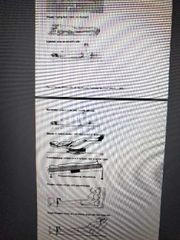
1.supine 2.prone 3.lateral 4.recovery 5.shock 6.tredelenburg 7.fowler 8.semi - Fowler
|
.. yo Male or female Patient found....... |
|
|
Directions |
Cephalic- at the head Caudal - at the feet |
Body atonomy related |
|
|
Body locations |
Anterior- front Posterior - back Right - right of the patient Left - left of the patient Lateral - towards the outside Medial- towards the middle or inside Superior- closer to the head, higher Inferior- further from the head, lower Proximal - close to the torso Distal - father from the torso Dorsal - towards the spine |
Body atonomy |
|
|
Respiratory System |
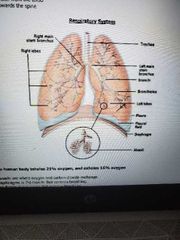
1.trachea 2. Right main stem bronchus 3.right lobes ( 3 lobes ) 4.left main stem bronchus 5.bronchi 6.bronchioles 7.left lobes ( 2 lobes) 8.Pleural 9.Pleural fluid 10.Diaphragm 11. Alveoli |
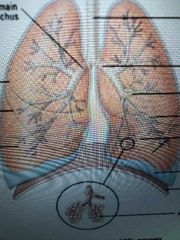
|
|
|
The human body inhale ......% oxygen.; and exhales .... % and retaining ... % |
21% 16% 5 % |
|
|
|
Alveoli |
are where oxygen and carbon dioxide exchange |
|
|
|
Diaphragm |
Is the muscle that controls breathing |
|
|
|
The brain |
Is the organ that controls breathing |
|
|
|
Digestive system |
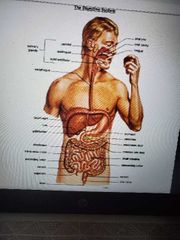
1.)pharynx 2.) Oral cavity 3.) Tongue 4.) Parotid 5.)sublingual 6.)submandibular 7.) 4, 5, 6 are the salivary glands 8.) Esophagus 9.) diaphragm 10.) Liver 11.) Gallbladder 12.) stomach 13.) Pancreas 14.) Pancreatic duct 15.) Duodenum 16.) Transverse colon 17.) ascending colon 18.) Common bile duct 19.) Small intestine 20.) Descending colon 21.) Cecum 22.) Appendix 23.) Rectum 24.) Anal Canal 25.) Anus |
24 parts/things make it up |
|
|
Abdominal Quadrants & Cavity |
Right upper quadrant Left upper quadrant Right lower quadrant Left lower quadrant |
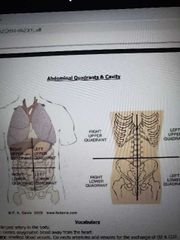
|
|
|
Aorta |
Largest artery in the body |
|
|
|
Artery |
Carries oxygenated blood away from the heart |
|
|
|
Capillary |
Smallest blood vessels. Connects arterioles and venules for exchange of O2 & CO2 |
|
|
|
Contusion |
Swollen ,raised skin and warm to the touch |
|
|
|
Ecchymosis |
A bruise , internal bleeding, but does not break skin |
|
|
|
Epistaxis |
Nose bleed |
|
|
|
Hematoma |
A mass of blood or pooling of blood in the soft tissues beneath the skin. |
|
|
|
Perfusion |
The circulation of blood through the tissue or organ |
|
|
|
Hypovolemic shock |
Bleeding shock, due to loss of fluid (blood or plasma) |
|
|
|
Pressure point |
A point where a blood vessel lies near a bone |
|
|
|
Vena cava |
Largest Vein in the body |
|
|
|
Veins |
Carries blood from the tissues back to the heart |
|
|
|
Cardiovascular system |
The heart and vessels |
|
|
|
Arterial blood |
Bright red in color. Spurts with each heart beat |
|
|
|
Venous blood |
Dark maroon in color. Flow steadily |
|
|
|
Capillary Blood |
Oozes from the wound. Color in between vein artery |
|
|
|
Bleeding and blood |
There are 5 to 6 liters of blood in the average adult. There are 10 to 12 pints of blood in the average adult body |
|
|
|
Blood consist of ? |
White blood cell Red blood cell Platelets Plasma |
4 types |
|
|
1. White 2. Red 3.platelets 4.plasma |
1. Fights infection 2.carry O2 3. Clot the blood 4. Fluid that carries the formed elements of blood |
|
|
|
Types of blood vessels |
1. Arteries 2.veins 3.arterioles 4.venules 5.capillaries |
|
|
|
Arteries |
Carry blood away from heart |
|
|
|
Veins |
Carry blood to the heart |
|
|
|
Arterioles |
Smaller arteries in the body |
|
|
|
Venules |
Smaller veins in the body |
|
|
|
Capillaries |
Smallest blood vessels that connect arterioles and venules |
|
|
|
Shock |
Shock refers to the state of collapse and failure of the cardiovascular system, which leads to inadequate perfusion (hypoperfusion). As the body compensates by redirecting blood flow from non-essential organs to essential ones. |
|
|
|
As the body compensates with the blood loss the following occurs |
1. Heat beats faster ( Tachycardia) 2.skin becomes pale, cool , sweaty 3.Rapid Breathing 4.Decrease blood pressure 5.cyanotic (skin turning blue due to lack of blood and oxygen ) 6. AMS (Altered mental status) 7. LOC ( loss of consciousness) 8. Coma 9.Major organs begin to shut down starting with (the kidneys, then the lungs ,then heart , then the brains shuts down ) in the sequence |
|
|
|
Types of shock |
1. Anaphylactic Shock 2.Cardiogenic shock 3.Hypovolemic shock 4.Respiratory insufficiency shock 5.Neurogenic shock 6.Psychogenic Shock 7. Septic shock
|
There are 7 of them |
|
|
Anaphylactic Shock |
Causes : Extreme life threatening allergic reaction
Sign and symptoms : * can develop within seconds * Mild itching or rash * Burning Skin * Vascular Dilation * Rapid Death * Generalize edema * Coma * Rapid death
Treatment: 1. Manage the area 2. Assist Ventilations 3. Administer High Flow Oxygen 4.Determine Cause 5.Epinephrine
|
Say Causes , then the signs and systems and then the treatment for it
7 answers and then 5 answers |
|
|
Cardogenic Shock |
Causes: * inadequate heart function * Disease of muscle tone * Impaired electrical system * Disease or injury
Sign & system: 1. chest pain 2.irregular pulse 3.weak pulse 4.low blood pressure 5.cyanosis ( lips and under nails ) 6. Cool , clammy skin 7. Anxiety
Treatment: 1.Position of comfort 2.Adminster oxygen 3. Assist Ventilations 4. Transport promptly
|
Say Causes , then the signs and systems and then the treatment for it
4 causes , 7 signs and 4 treatment |
|
|
Hypovolemic |
Cause : loss of blood or fluid
Signs and symptoms: * rapid , weak pulse * low blood pressure * change in mental status * cyanosis( lip ,under nails ) * cool, clammy skin * Increased respiratory rate Treatment 1. secure airway 2.assist ventilations 3. Administer highflow oxygen 4.control external bleeding 5.Elevate legs 6.keep warm 7.Transport promptly
|
1 of the 7 shocks |
|
|
Respiratory Insufficiency |
Causes: severe chest injury Airway obstruction
Signs and symptoms: ●Rapid , weak pulse ○ Low blood pressure ● change in mental status ○cyanosis ( lips, under nails ) ● Cool clammy skin ○ Increase respiratory rate
Treatment: 1. Secure airway 2.Clear air passage 3.Assist Ventilations 4.Adminster highflow oxygen 5.Transport promptly
|
1of the 7 shocks |
|
|
Neurogenic |
Cause: * Damaged Cervical spine, which causes widespread blood vessel dilation
Signs and symptoms: + Bradycardia ( slow pulse ) + low blood pressure + Signs of neck injury Treatment: 1. Secure airway 2. Spinal Stablization 3. Assist Ventilations 4. Administer High-Flow 5. Preserve body heat 6.Transport promptly
|
1 of the 7 shocks |
|
|
Psychogenic ( fainting) |
Cause: * Temporary, generalized vascular dilation * Anxiety, Bad news , sight of injury, or blood prospect of medical Treatment , severe pain,illness, tiredness Sign and systoms - Rapid pulse - normal or slow BP Treatment : 1.Determine duration of unconscious 2.Record initial vital signs and mental status 3. Suspect head injury if patient is confused or slow to regain consciousness 4.transport promptly |
Another 1 of the 7 shocks |
|
|
Septic Shock |
Cause: * Severe infection
Signs and Symptoms: warm skin + Tachycardia +Low blood pressure
Treatment: 1.Transport promptly 2.Adminster oxygen en route 3.provide full ventilatory 4. Elevate Legs |
Last shock |
|
|
MAST |
Military Anti Shock Trousers |
Gear for shock |
|
|
PASG |
Pneumonic Anti Shock Garment Within New York, the above mentioned garments are never used.once pants are placed on , they cannot be removed unless, it is done by a doctor |
Shock gear like MAST |
|
|
About Mast and its Application |
Apply Mast : In adults with major blunt trauma, if the systolic blood pressure is below 50 mm hg and signs of inadequate perfusion are present , inflate all three compartments to the recommended pressure or until the pop - off valves of all three compartments pop open In adults with major blunt trauma, if the systolic blood pressure is below 90 mm hg and signs of inadequate perfusion and an unstable pelvic fracture is present inflate all three compartments to the recommended pressure or until the pop - off valves of all three compartments pop open |
How to use |
|
|
Progression of shock |
Compensated Decompensated Terminal stage |
|
|
|
Compensated |
Higher pulse , pale, cool , clammy , nauseous, anxious and rapid breathing. |
|
|
|
Decompensated |
BP below 90mmhg systolic, labored breathing, cyanotic skin , dull eyes, absent peripheral ( Pulses found in extremities), AMS ( Altered Mental Status ) , LOC ( loss of consciousness) |
|
|
|
Terminal Stage |
Vital Organs begin to fail, in this sequence: kidney , lungs ,heart , brain |
|
|
|
Types of burns |
Thermal Chemical Radiation Electrical Light |
5 types |
|
|
Thermal burn |
Cause by fire, steam or hot objects |
|
|
|
Chemical |
Cause by acid or alkaline |
|
|
|
Radiation |
Caused by nuclear or some similar source |
|
|
|
Electrical |
Caused by lightning or electrical wiring |
|
|
|
Light |
Caused by sunlight or artificial UV lamps |
|
|
|
Depths of burns |
Adults- Head and neck = 9 % Anterior torso = 18 % Posterior torso = 18 % Each leg = 18% Each arm= 9 % Gentalia = 1%
Total of 100 % of the body
Child
Head and neck = 18 % Genitalia / perineum = 1% Total of 100 % of the body Child Head and neck = 18 %Anterior torso = 18 %Posterior torso =18 %Each leg = 13.5%Each arm = 9 %Genitalia = 1 % Anterior torso = 18 % Posterior torso =18 % Head and neck = 18 %Anterior torso = 18 %Posterior torso =18 %Each leg = 13.5%Each arm = 9 %Genitalia = 1 % Each leg = 13.5% Each arm = 9 % Genitalia = 1 %
For a total of 100% |
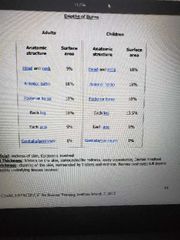
|
|
|
Superficial (burn) |
Redness of the skin, epidermis involved |
1 of 3 |
|
|
Partial Thickness (burn) |
Blisters of the skin, surrounded by redness , waxy appearance, Dermis involved |
2 out of 3 |
|
|
Full Thickness (burn) |
Charring of the skin, surrounded by blisters and redness. Nerves destroyed full dermis and possibly underlying tissues are involved |
|
|
|
Burns in Adults |
Critical burns: -Full thickness burns involving the hand, feet , face , upper airway , gentalia , or circumferential burns of other areas. - Full thickness burns covering more than 10% of the body's total surface area. - Partial thickness burns covering more than 30% of the body's total surface area. - Burns associated with respiratory injury ( smoke inhalation or inhalation injury ) - burns complicated by fractures. - Burns on patients younger than 5 years or older than 55 years other would be classified as "moderate " in young adults. |
|
|
|
Moderate burns in adults |
-Full thickness burns involving 2 % to 10% of the body's total surface area ( excluding hands, feet, face, gentalia, or upper airway) - Partial thickness burns covering more than 15% to 30% if the body's total surface area - superficial burn covering more than 50% of the body's total surface area |
|
|
|
Minor burns in adults |
- Full thickness burns covering less than 2 % of the body surface area - partial thickness burns covering less than 15% of the body surface area - superficial burns covering less than 50% of the body's total area |
|
|
|
Critical burn on infant/ children |
- Fulll thickness or partial thickness burns covering more than 20% of the body's total surface area. - Burns involving the hands, feet, face , airways or gentalia. |
|
|
|
Moderate burn on children/ infants |
" partial thickness burns covering 10% to 20 % of the body's total surface area |
|
|
|
Minor burn on children or infants |
- Partial thickness burns covering less than 10% of the body's total surface area |
|
|
|
Treatment of Burns |
1. Follow Bsi precautions to help prevent infection.( remove hot clothing and jewelry as necessary.
2. Move patient away from the burning area
3. Soak the burning skin in cool , sterile water or cover with a clean, wet , cool dressing if the skin is hot
4. Provide high flow oxygen
5.Rapidly estimate the burn severity
6.Check patient for traumatic injuries or other medical conditions
7. Treat the patient for shock 8. Prevent further heat loss by covering the patient with warm blankets. 9. Provide prompt transport
|
|
|
|
Less than 10% of the body |
Use moist , sterile dressing |
|
|
|
More than 10% of the body |
Use dry , sterile dressing |
|
|
|
Chemical Burns |
1. Stop the burning process. Safely remove any chemical from the patient , always brushing off dry chemicals 2.Remove patient clothing , cut clothing off if you have to 3. Irrigation with copious amounts of water for 20 mins
|
|
|
|
Electrical Burns |
1.ensure scene is safe. 2. If indicated, begin CPR and apply the Aed 3.Treat soft tissue areas by placing dry , sterile dressings, on all burn wounds and splinting |
|
|
|
Epidemis |
Tough external layer, that forms a water tight seal |
Skin |
|
|
Dermis |
Layer that consist of hair follicles, sweat glands , ect |
|
|
|
Subcutaneous |
Tissue above the bone |
|
|
|
Functions of the skin |
- keep bacteria out
- keep water in ( human body is made up 80 % water )
- regulate temperature ( when too hot, we sweat , too cold , skin tightens ) |
3 listed |
|
|
Skin colors |
- Pale- pallow : shock ( mucous membrane) - Cyanosis : Lack of oxygen to the tissue ( blue/Grey ) - Jaundice: hepatitis ( liver problem) ( yellow skin) - Flush: Red ( allergic reaction, high blood pressure )
|
|
|
|
Abrasion |
Rubbing of the skin/scraping |
Wounds |
|
|
Laceration |
Jagged cut ( treat with bleeding control ) 1. Direct pressure to the wound . 2.consider the use of hemostatic gauze 3.additional dressing if needed. 4.wrap with pressure bandage 5.tourniquet 6.Treat for shock and transport |
|
|
|
Avulsion |
A flap of tissue either hanging or falling off |
Wound |
|
|
Incision |
Straight, clean cut ( treat with bleeding control) |
Wound |
|
|
Puncture |
Wound that is deeper than it is wide ( treat with bleeding control) |
Wound |
|
|
Evisceration |
Internal organs are outside of the body 1. Cover with moistened sterile gauze 2. Occlusive Dressing- tape all four sides |
Wound |
|
|
Amputation |
1. Wrap the stump with moist sterile dressing
2.cover the dressed stump with a dry bandage.
3. Preserve the amputated part as follows :
4. Moisten an appropriately sized sterile dressing with sterile saline solution.
5. Wrap the severed part in the moistened sterile dressing , preserving all amputated material
6. Place the severed part in a water tight container ( i.e sealed plastic bag )
7.place the container on ice or cold packs ( if available) Do not freeze or use dry ice! Do not immerse the amputated part directly in water ! DO NOT allow amputated part to get in direct contact with ice !
8. Immobilizate the linv to prevent further injury Transport the amputated part with the patient. |
|
|
|
Impaled Object |
- Object is still in wound 1. Do not attempt to remove the impaled Object. Stabilize the object. Note that the only time you should remove an impaled object is when it goes through the cheek. 2. Control the bleeding and stabilize the object in place by using soft dressing , gauze and or tape. 3. Tape a rigid item over the stabilized object to protect it from movement during transport. |
|
|
|
Closing injuries and internal Bleeding |
Treat a close soft tissue injury by applying the acronym RICES :
- Rest: keep the patient as quiet and comfortable as possible
- ICE: or cold pack , slow bleeding by causing the blood vessels to constrict and also reduces pain.
- Compression : over the injury site slow the bleeding by compression of thr blood.
- Elevation: of the injured part just above the level of the heart decrease swelling
- Splinting: decrease bleeding and also reduces pain by immobilizing a soft tissue injury or an injured extremity |
Wound related |
|
|
Axial skeleton |
Composed of the skull, spine, ribs and sternum |
Upper |
|
|
Appendicular skeleton |
Compose of upper and lower extremities ( UE and LE) |
|
|
|
The human body consist of ---- total bones |
206 |
|
|
|
There are ____ bones in the face/skull |
14 |
|
|
|
THERE are ___ bones in the spine |
33 - 7 cervical ( susceptible to injury ) -12 thoracic -5 lumbar . - 5 Sacral - 4 coccyx (sacral and coccyx are fused together) .. Spinal Cord ends between L1 and L2 , cord protects itself by 20 -21 vertebrae |
|
|
|
Muscle |
Voluntary: muscles you have control over . Skeletal muscles. Involuntary: smooth muscles ( digestive tract ) Cardiac: involuntary muscle only found in the heart |
3 kinds |
|
|
Upper extremities include |
Scapula , humerus , radius/ulna, carpals, metacarpals, and phalanges. |
|
|
|
Lower extremities includes |
Femur , patella, tibia / fibula , tarsal metatarsals and phalanges. |
|
|
|
Calcaneus |
Heel bone |
|
|
|
2 types of Joints |
Ball & Socket : located in the hip and shoulder ( permits 180 degree). Hinge joint : fingers , elbows, knee (permits back and forth motion only ) |
|
|
|
Ligament |
Fibrous tissue connects bone to bone |
|
|
|
Tendon |
Fibrous tissue connect muscle to bone |
|
|
|
Injured tendon and/or ligament |
An injured ligament is called a sprain An injured tendon is called a strain If sprain , strain or fracture, treat all painful , swollen or deformed extremities as a fracture. |
|
|
|
Fractures |
Open: refers to broken skin or compound
Closed: refers to inside the skin or simple
Green stick: (hairline) a non-displaced fracture .
Displaced : an angulated fracture With fractures, you will hear crepitus ( bones scraping together) when you palpate the patient.
|
|
|
|
Signs & Symptoms of a Fracture |
- Deformity - Guarding - Crepitus - Tender - swelling - Bruising |
|
|
|
In a Fracture, look for the following : |
- look for pulse : if there is no pulse , that means there is no blood flow. - Can the patient move it - Does the patient have any sensation. If the patient can feel your touch distal to the site of the fracture means that the nerve supply is still intact. |
|
|
|
Central Nervous System |
- (CNS) consists of the brain and spinal cord. |
|
|
|
Peripheral Nervous System |
Made up of all sensory , motor & connecting nerves in rest of the body. The Peripheral Nervous System has two anatomic parts: - 31 pairs of spinal nerves - 12 pairs of Cranial nerves |
|
|
|
Concussion |
Mild , closed injury , without detectable damage to the brain . (Amnesia is short lived) Full recovery is usually the case. |
|
|
|
Contusion |
Bruised brain , fractures or dents on the head can cause rupture of blood vessels in the brain. |
Brain injuries |
|
|
Hematoma |
Intracranial Bleeding |
Brain injuries |
|
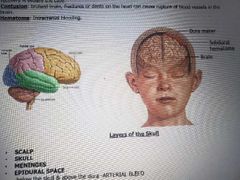
The lobes and image |
Parietal lobe Occipital lobe Frontal lobe Temporal lobe Dura mater . Subdural hematoma Brain |
|
|
|
Layers of the skull |
- Scalp : skin covering head - skull : bony structure of the head - meninges: the 3 membrane (dura mater ,arachnoid and pia mater ) - epidural space ( below the skull and above the dura aterial bleed ) - dura mater ( below the dura & above the arachnoid-Venous Bleed) - Arachnoid •sub-arachnoid space •Cebral spinal fluid - Pia Mater : inner most membrane enveloping the brain and spinal cord
|
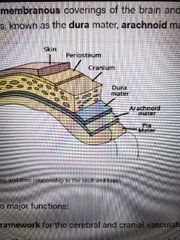
|
|
|
Foramen Magnum |
Hole in the bottom of the skull where bottom of the brainstem / top of the spinal cord exists. |
|
|
|
Signs & Symptoms of head injury |
1. Laceration of the scalp 2.soft area upon palpation 3.deformities of the scalp 4.Battles sign behind ear 5.unequal pupils 6.Amnesia 7.Numbness of extremities 8.Visual Complaints 9.contusions to the scalp 10.Depression upon palpation 11.Ecchymosis about the eyes 12.CsF leakage from scalp wound 13. Loss of sensation 14. Seizures respiration 16.nausea or vomiting 17.hematoma to the scalp 18. Visible fractures of the scalp 19. Raccoon eyes 15.irregular respiration 16.nausea or vomiting 17.hematoma to the scalp 18. Visible fractures of the scalp 19. Raccoon eyes 20.Csf leakage from nose and ears 21. Loss of motor function 22.Period of unconsciousness 23.Dizziness 24.Combative or other abnormal behavior 20.Csf leakage from nose and ears 21. Loss of motor function 22.Period of unconsciousness 23.Dizziness 24.Combative or other abnormal behavior |
|
|
|
Suspect head & Spine injuries with following MOI |
- Motor vehicle Crash - Pedestrian - motor vehicle collision - falls - Blunt Trauma - Penetrating Trauma to the head,Neck or Torso - Motorcycle Crashes - Hangings - Diving accidents -Recreational Accidents |
|
|
|
Measurement of Respiratory Rate |
A.) Normal 12 to 20 - adult; 1 breath = 1 inhale + 1 exhale B.)Take for 30 seconds and multiply by 2 or 1 full minute C.)Under 12 Breaths per min = Bradypnea D.) Over 20 breaths per min = Tachypnea E.) Deep Respirations = Hyperpnea F.) Hyperventilation = Tachypnea & Hyperpnea. G.) Consider Assisting ventilation if necessary < 8 or >24 with signs of inadequate breathing and signs of inadequate oxygenation ( confusion,restlessness,cyanosis ) H.) Concerned with quality and quantity of respiration •Deep/Labored •Shallow •Normal |
|
|
|
Measurement of Pulse Rate |
A.) Normal 60 - 100 for adult; for children 70-150; for infants 100-160. B.) As with respiration 30 second and multiply by 2 C) under 60 beats per minute = Bradycardia D.) Over 100 beats per minute = Tachycardia E.) Use Radial artery for convenience F.) Concerned with quality of pulse too : •weak/thready • Strong/pound • Regular pattern •irregular patern |
Pulse |
|
|
Measurement of blood pressure |
A .] Systolic / Diastolic
Systolic : pressure on the arterial wall during contraction of the heart ( systole )
Diastolic: pressure on aterial walls during relaxation of the heart ( diastole ) Emt dont diagnose hypertension Emt treat hypotension by elevating the legs
( not part of the guide )
BP can be measuring by palpation only systolic can be obtain.
And most commonly ausculation |
|
|
|
Nasopharynx |
Nasal cavity |
|
|
|
Oropharynx |
Mouth, epiglottis, larynx( vocal cord) |
|
|
|
Lower airway |
Trachea , major bronchi down to the diaphragm |
|
|
|
Inhalation |
Diaphragm contract or moves down causing the thoracic cavity to expand, ribs expand or move up and out |
|
|
|
Exhalation |
Diaphragm relaxes , moves up causing the lungs to empty, the thoracic cavity gets smaller. |
|
|
|
Tidal volume |
amount of air you move in 1 breath |
|
|
|
Hypoxic drive |
Brain measures the amount of oxygen in your arterial blood . Low PaO2 causing breathing |
|
|
|
Normal drive |
Brain measures amount of carbon dioxide in your arterial blood . High PcCo2 causes breathing |
|
|
|
Inhale / exhale |
Inhale : 21% Oxygen 79% nitrogen .04%Carbon Dioxide Exhale: 16% oxygen 79% Nitrogen 4% Carbon Dioxide |
|
|
|
Apnea |
(Apneic ) absence of breathing |
|
|
|
Dyspnea |
(Dyspneic) difficulty breathing |
|
|
|
Hypoxia |
Low levels of oxygen in the blood |
|
|
|
Cheyne-Stokes |
Regular , then irregular breathing with periods of apnea. |
|
|
|
Agonal Respiration |
Occasional Gasping noises that you hear when heart has already stopped. (Agonal respiration should be treated as apnea ) |
|
|
|
Heart attack |
( myocardial infarction) insufficient oxygen being provided to the tissues of the heart. |
Some possible cause of hypoxia |
|
|
Pulmonary edema |
Fluid accumulates in the lungs. Exchange of O2 and CO2 is less efficient |
|
|
|
Narcotic or sedative overdose |
Respiration may become decreased or shallow ( reduced tidal volume) |
|
|
|
Smoke inhalation or toxic fumes |
Cause pulmonary edema , destroys lung tissue causing problems with gas exchange |
|
|
|
Stroke |
Cerebrovascular Accident aka cva) may be due to facial paralysis leading to potential airway compromise or poor control of respirations if the respiratory center in the brain is damage |
|
|
|
Chest injury |
Pain interferes with full chest wall expansion , thus limiting full lung expansion. Lung damage itself secondary to pulmonary contusion can also prevent efficient gas exchange |
|
|
|
Shock |
(Hypoperfusion) often occurs as a result of injuries that affect the circulatory system. When the circulatory system fails to deliver adequate amounts of oxygen, the tissue begins to die. |
|
|
|
Chronic Obstruction Pulmonary Disease |
(COPD) chronic irritation of the lungs and air passage produces alveolar damage and poor gas exchange. Chronic Bronchitis or emphysema. |
COPD |
|
|
Asthma |
Narrowing of Lower respiratory passages and buildup of mucus causes air trapping and poor gas exchange. |
|
|
|
Premature Birth |
Pulmonary surfactant is decreased in some premature infants, and, the worse the hypoxia is . |
|
|
|
COPD (breakdown) |
COPD is a catchall diagnosis COPD is the end result of a slow process that constant damage to the airway , the alveoli & the pulmonary Vessels Operating on the hypoxic drive ( measure amount of o2 in aterial blood instead of Co2) Cause: Asthma , Bronchitis, Emphysema, Smoking , Toxic fumes. |
|
|
|
Asthma |
Smooth muscle spasms of smaller air passages with the buildup of mucus. |
|
|
|
Bronchitis |
Similar to asthma except the inflammation occurs in the bronchi |
|
|
|
Chronic |
annual or long term condition |
|
|
|
Acute |
First episode |
Sudden |
|
|
Hemo Pneumothorax |
Blood and air in the thoracic cavity |
|
|
|
Hemo thorax |
Only blood in the thoracic cavity |
|
|
|
Tension Pneumothorax |
As air begins to fill the thoracic cavity , it begins to push everything towards the opposite side of the wound resulting in a shift in the trachea |
|
|
|
Cups |
Critical Unstable Potentially unstable Stable |
|
|
|
Spontaneous Pneumothorax |
When a lung collapses or pops without any injury or trauma to the body |
|
|
|
Femur |
Mild Shaft Broken Femurs get a Traction splint A traction splint can only be used with an isolated femur injury , meaning if another is exists to the tib/fib area , ankle or pelvis splint cannot be applied |
|
|
|
About fracture |
- if fracture has a pulse, splint it as you find it. - if Fracture does not have pulse You are allowed as an Emt to try to Gently realign the extremity 1 time only , if pain increase or joint doesn't move, splint in place and transport |
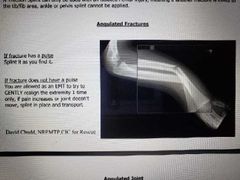
|
|
|
Stabilization |
Procedure done by a person |
|
|
|
Immobilization |
Procedure done by equipment ( splint , slings , swathes). |
|
|
|
Heart |
- There are 4 Coronary Arteries - The heart is divided into two parts - The right and the left |
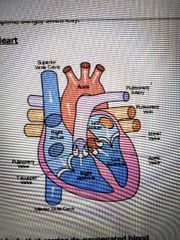
|
|
|
Heart blood Flow |
From the superior & inferior Vena Cava Blood enters the Right Atrium. From the Right Atrium it travels to the Right Ventricle.From the right ventricle it enters the Pulmonary Arteries. From the pulmonary arteries it enters the Lungs. Up to this point, all of the blood has been deoxygenated.From the lungs the blood flows into the Left Atrium. From the Left Atrium it enters the Left Ventricle. From the left Ventricle it pumps into the Aorta and out to the body and tissue until it returns to the heart. |
|
|
|
Pulmonary Artery |
Is the only artery in the body that Carries deoxygenated blood |
|
|
|
Pulmonary Vein |
Is the only vein in the body that Carrie's oxygenated blood |
|
|
|
Valves of the heart |
Pulmonary Valve
Tricuspid Valve
Mitral Valve ( bicuspid valve)
Aortic Valve
|
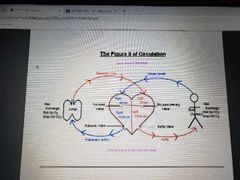
|
|
|
General Pharmacology |
-All drugs have four different names: •Official name •Chemical name •Generic name •Trade name |
|
|
|
Indication |
a condition for which the drug is recommended |
Terminology |
|
|
Contraindication |
A situation that prohibits the use of a drug or piece of equipment. |
Terminology |
|
|
Depressant |
Lessons that activity of the body . ( #1 Otc is Alcohol) |
Terminology |
|
|
Stimulant |
Increase the activity in the body . ( amphetamine- wide eyed appearance)
|
Terminology |
|
|
Narcotic |
Strong pain reliever ( depressant - constricted or pin point pupils ) |
Terminology |
|
|
Hallucinogen |
Think your superman and jump out a window |
Terminology |
|
|
Therapeutic Action |
Beneficial action of the drug |
Terminology |
|
|
Side Effect |
Unwanted effect |
Terminology |
|
|
Drug |
A chemical substance used in the treatment, cure , prevention, or diagnosis of a disease or used otherwise to enhance physical and mental wellbeing. |
Terminology |
|
|
Pharmacology |
The science of drugs , including their ingredients , preparations , uses , and actions on the body. |
Terminology |
|
|
Routes |
1.Inhalation. 2.ingested 3.sublingual 4.auto injector 5.transdermal 6.intravenous (IV) 7.Intramuscular (IM) 8.intraosseous (IO) 9. Subcutaneous (SC) 10. Per rectum ( PR) |
|
|
|
Six Rights of Medication |
1. Right patient verification 2. Right time to administer medication 3. Right medication to administer to the patient 4. Right route to use 5. Right dosage to administer to the patient 6. Right documentation |
The 6 rights |
|
|
Common Drugs On The Ambulance |
Name 1.)Oxygen 2.)Oral Glucose 3.) Activated Charcoal 4.) Aspirin 5.) Albuterlol
Class 1.) Inhaled Gas 2.) Ingested Gel 3.) Suspension 4.) Blood thinner Analgesic 5.) Bronchodilator
Dosage 1.) 2 Lpm to 15 LPM 2.) 1 tube 3.) Unclear 4.) 4 tablets of 81 mg each 5.) 1 tube
Indication 1.)hypoxia from any cause 2.) Ams due to low blood sugar 3.) Poisoning 4.) Chest Pain 5.) Respiratory distress due to COPD
Contraindications 1.) none 2.)not given when unconscious 3.)not give when unconscious 4.)Allergies to aspirin or blood disorder. 5.) If cardiac history exists, must contact OLMD for permission
Side Effects 1.) None 2.) High Sugar 3.) Vomiting, Diarhea 4.) Pain killer Blood thinner 5.) Tachycardia, Anxiety , Palpitations
|
|
|
|
Nitroglycerin |
Class- Sublingual Vasodilator
Dosage - O.4 mg or 1 tablet every 5 minute.
Indications - chest pain & if BP is above 120 systolic
Contraindication- if BP is below 120 systolic or hypotension
Side effects - headache , nausea , low BP
Cannot administer nitroglycerin if patient have taken levitra , cialis , or viagra within the last 72 hours.
|
Administration |
|
|
Epi- Pen |
Class: beta agent Dosage: 0.30 mg adults , 0.15mg Pediatric Indications: Anaphylactic Reaction Contraindication: none Side Effect: Tachycardia , Anxiety |
|
|
|
Pneumothorax ( explained ) |
- air in pleural or thoracic cavity •Diminished lung sounds on one side •Trachea Deviation •Unilateral chest expansion |
|
|
|
Hemothorax ( explained ) |
Blood in the pleural or thoracic cativity ( same systoms as above ( pneumo) ) |
|
|
|
Hemopneumothorax |
Blood and air in the pleural or thoracic cavity ( same systoms as above) ( the others ) |
|
|
|
Spontaneous Pneumothorax |
No outside injury |
|
|
|
Flail Chest |
When two or three ribs are broken in two or three places |
|
|
|
Paradoxal movement |
When the body inhales , the space where the ribs are broken , does not expand . When the body later exhales , the chest cavity constrict causing the broken ribs to extend further than where the thoracic cavity usually rests. |
|
|
|
Traumatic Asphyxia |
Occurs when a great deal of force is applied to the chest. This causes : JVD , hemorrhage in the sclera ( the white part ) of the eye , Cyanosis of the face and neck. |
|
|
|
Pericardial Tamponade |
When blood or fluid from the heart collects in the sac surrounding the heart (pericardium) decreasing the ability of the heart to beat. |
|
|
|
Subcutaneous Emphysema |
When the trachea is fractured and air escapes into the subcutaneous layer of the skin |
|
|
|
Air embolism |
Occurs if the jugular vein is cut and begins to suck in air as the heart pumps. This will cause air to travel to the heart and could cause death if air pocket is large enough. |
|
|
|
Arteriosclerosis |
Hardening of the arteries due to calcium deposits. |
Coronary Artery Disease ( CAD ) |
|
|
Atherosclerosis |
Narrowing of the arteries due to plaque build up |
|
|
|
Angina Pectoris |
Short lived chest pain, approximately 5 mins , usually cured with rest , oxygen and nitroglycerin |
|
|
|
Acute Myocardial Infaction ( AMI ) . |
Heart attack. Cause sudden blockage of coronary arteries |
|
|
|
Embolism |
Clot |
|
|
|
Occlusion |
A clot that gets stuck in a small vessel. Also know as Thrombus. |
|
|
|
Aneurism |
Weakening of a blood vessel that eventually bursts. |
|
|
|
Congestive Heart Failure |
Problem with the pumping action of either the R or L heart
- If the problem is in the R heart you will see jvd , pedal edema of the ankles , abdominal edema and cyanosis of the lips .
- If the problem is in the L heart this means the lungs are filled with liquid and patient has pulmonary edema , wheezing , rales and ronchi. Once blood is back up enough you will see the pink frothy sputum. Once this occurs , the patient no longer has CHF , they have APE or Acute Pulmonary Edema.
These patients must be transported sitting up or they will drown in their own fluids. |
|
|
|
Cause of AMS |
1. Strokes 2.Seizures 3.Diabetes 4.Poisoning/ Overdose 5.hypoxia 6.Behavioral / Emotional Problems 7.Head Trauma |
Altered mental status |
|
|
Stroke |
TIA: transient ischemic Attack or temporary cell death . Also know as mini stroke. Tia is a temporary neurological deficit lasting approximately 5 to 10 minutes , causing by an interruption of blood flow to the brain. Cva: cerebral vascular Accident Cva is an interruption of blood flow to the brain caused by either a clot or an aneurism |
|
|
|
Signs and symptoms of cva |
1.upequal pupil 2. Dizziness 3.severe headache 4.droopy mouth 5.slurred or no speech 6.impaired Vision 7.weak / paralyzed on one side . To test for a cva : Cincinnati prehospital stroke scale 1. ask patient to smile 2.ask patient to lift arms parallel to the floor 3. Ask the patient to repeat a simple sentence. If patient fails 2 of the 3 skills , transport the patient to a stroke center immediately. |
|
|
|
Seizures |
Are sudden , violent , involuntary contractions of a group of muscles caused by a disturbance in a brain function. |
|
|
|
Grand Mal |
Also known as a generalized seizure, has 4 stages 1. Aura: the warning stage , only patient can see or smell something 2. Tonic : the body tightens the muscles 3. Clonic : the thrashing stage 4. postictal : patient may be AMS , tired or minimally responsive |
|
|
|
Transport for Grand mal |
1. Clear area 2. Time the seizure 3. In Postical stage , lay patient in recovery position
Head trauma can cause seizures or make someone become prone to seizures. |
Seizure |
|
|
Diabetes |
Diabetes is the number 1 epidemic in the US. Type 1 diabetes - insulin injections Type2 diabetes - diet/exercise / oral medications |
|
|
|
Hypoglycemia ( insulin Shock ) |
Occurs ad a result of low blood sugar or hypoglycemia Too much insulin Not enough food or carbohydrates |
|
|
|
Signs and systoms of insulin shock |
1. Weak 2. Dizzy 3. AMS 4.clammy skin 5.pale and cool skin 6.hunger pains 7.Seizures
Treatment & Tx ABC's, give O2 , oral glucose , etc; as long as the patient can swallow Quick onset |
Hypoglycemia |
|
|
DC ( Diabetic coma |
Occurs as a result of high blood sugar or hyperglycemia. Too much food and carbohydrates Not enough insulin |
|
|
|
DC signs and symptoms / tx |
1. Sleepy 2. Very thirsty 3.Dry lips 4.warm , dry skin 5.fruity breathe odor 6.frequent urination 7. Unconsciousness/ coma 8. Blurry vision T×( transport ) ABC's, give oxygen, rapid transport to ED ( emergency department) , IV fluids ( ALS ) Slow onset |
Diabetic coma |
|
|
Poisoning/ Overdose |
Ingested : swallowed Inhaled : breathed in Injected : IV , Bee sting from a honey bee Absorbed : Chemical or poison plants through the skin |
4 ways |
|
|
Snake bite |
1. ABC's 2. Give O2 3.leave the limb below the level of the heart |
|
|
|
Bee sting |
1. ABC's 2. Give O2 3.Scape stinger off with a solid card. 4.remove jewelry from the site , shoes and socks if on the legs. |
|
|
|
Narcotics |
Opium base drugs . Pinpoint or constricted pupils |
|
|
|
Barbiturate |
Sedative , depressants. Pupils are fixed or dilated. |
|
|
|
Amphetamine |
Wild eyes appearance, very excited , Tachycardia |
Overdose |
|
|
Hallucigen |
PCP, violent, very strong |
Overdose |
|
|
Alcohol withdrawal |
DTs ( Delirum tremors) , high mortality rate |
|
|
|
Allergies |
Signs and symptoms 1.sneezing 2.Itchy , runny nose 3.itchy,runny eyes 4.itchy skin , rash ( urticara) 5. Wheals ( looks like circles on the skin ) |
|
|
|
Signs and symptoms of anaphylaxis |
1. Chest tightness 2.audible wheezing 3. Swelling of the lips and tongue 4.labored breathing |
|
|
|
Hypoxia |
Is a dangerous condition in which the body tissue and cells are not receiving enough o2 |
|
|
|
EDP |
Emotionally disturbed Person |
|
|
|
Hypothermia |
Low body temperature 1. Conduction : direct transfer of heat from a part of the body to a colder object.. 2. Convection: heat is lost because of circulating air ( wind) . Evaporation: when the body sweats , water on the skin evaporates , cooling the body off. The body loses heat in 5 ways 1. Conduction : direct transfer of heat from a part of the body to a colder object..2. Convection: heat is lost because of circulating air ( wind) 3. Evaporation: when the body sweats , water on the skin evaporates , cooling the body off.4. Radiation : heat of the body lost through infrared Rays ( football players smoking heads ) 5. Respiration : loss of body heat through exhalation of warm air and inhalation of cold air. 4. Radiation : heat of the body lost through infrared Rays ( football players smoking heads ) 3. Evaporation: when the body sweats , water on the skin evaporates , cooling the body off.4. Radiation : heat of the body lost through infrared Rays ( football players smoking heads ) 5. Respiration : loss of body heat through exhalation of warm air and inhalation of cold air. . Evaporation: when the body sweats , water on the skin evaporates , cooling the body off.4. Radiation : heat of the body lost through infrared Rays ( football players smoking heads ) 5. Respiration : loss of body heat through exhalation of warm air and inhalation of cold air. 5. Respiration : loss of body heat through exhalation of warm air and inhalation of cold air. |
5 ways C C E R R |
|
|
Stages of hypothermia |
- Mild hypothermia : body temp is between 93 to 95 . Shivering, numbness , rapid respiration , rapid pulse , shivering is the first of hypothermia - Moderate hypothermia: body temp is between 86 - 93. Disoriented (Ams) ,confused ,lethargy , slow pulse , slow breathing. - Severe Hypothermia : body temp is less than 86 .may not be able to obtain vital signs |
|
|
|
Transport for hypothermia |
ABC , high flow O2 with BVM , remove wet clothing,cover with warm blankets , turn heat on |
|
|
|
Drowning |
Treat all drowning victims with spinal precautions Begin rescue breathing in the water . Begin chest compressions out of the water. |
|
|
|
SCUBA |
Stands for self contained underwater breathing apparatus |
|
|
|
Air embolism ( occurs) |
occurs when diver holds breath and ascends quickly . Causing air bubbles in the blood. |
|
|
|
Decompression Sickness |
Also known as the bends.Creates nitrogen bubbles in the joints and tissue . Occurs over several hours. Transport the patient on their left lateral side , head lower than the feet, cause by rapid ascent. |
|
|
|
AED ( automated external defibrillator) |

An Emt can administer a maximum of 3 shocks on the scene then transport must be initiated If 1 no shock in advised perform CPR on the way to the hospital. |
|
|
|
Behavioral Emergency |
Ask yourself ; is there a medical reason why this person acting this way ? 1. Head trauma 2.stroke 3.hypoglycemia 4.hypoxia 5.drugs 6.overdose 7.alcohol |
|
|
|
Behavior |
The manner in which a person acts |
|
|
|
Behavioral Emergencies |
When a person exhibits abnormal behavior that is unacceptable or intolerable to the patient or society |
|
|
|
Addictive disorder |
Characterized by a chronic use of an agent and resulting in a development of tolerance , psychical dependence, and drug seeking behavior. |
Psychological/ psychiatric disorders |
|
|
Anxiety disorder |
A blanket term covering several different forms of abnormal, pathological anxieties , fears and phobias. |
Psychological/ psychiatric disorders |
|
|
Autism disorder |
Characterized by impaired social interaction and communication and by restricted and repetitive behavior . |
|
|
|
Dissociative Disorder |
Conditions that involve disruptions or breakdowns of memory , awareness, identity and or perception. |
Psychological/ psychiatric disorders |
|
|
Eating Disorder |
A compulsion to eat , avoid eating , which negatively affects a person's physical and mental health |
Psychological/ psychiatric disorders |
|
|
Mood Disorder |
Where a disturbance in a person's emotional mood is hypothesized to be the main underlying feature |
Psychological/ psychiatric disorders |
|
|
Learning Disorder |
Characterized by group of disorders which affect a broad range academic and functional skills including the ability to speak , listen , read,write, spell, reason and organize information. |
Psychological/ psychiatric disorders |
|
|
Personality disorders |
Characterized by rigid and ongoing patterns of feeling, thinking, and behavior that deviates from the expectations of the culture of the individual who exhibits it. |
Psychological/ psychiatric disorders |
|
|
Schizophrenia Disorders: |
Characterized as a loss contact with reality (psychosis),hallucinations ( usually hearing voices ), firmly held false beliefs ( delusions) , abnormal thinking , a restricted range of emotions ( flattened affect ) , diminished motivation, and disturbed work and social functioning. |
Psychological/ psychiatric disorders |
|
|
Positional Asphyxia |
Death of a person due to the body position restricting breath |
|
|
|
Aspiration |
Obstruction in the throat which goes into the lungs |
|
|
|
Asphyxia |
Impaired or impeded breathing |
|
|
|
Fetus |
Developing baby |
|
|
|
Uterus |
Muscular organ where fetus develops |
|
|
|
Cervix |
Neck of the uterus |
|
|
|
Vagina |
Birth Canal |
|
|
|
Placenta |
Sac, which the attaches to wall of uterus & nourishes baby |
|
|
|
Umbilical cord |
1 inch wide , 22 inch long lifeline |
|
|
|
Amniotic Sac |
Bag of water ( 1-2 quarts) in which baby floats. ( Clear yellowish fluid , musty odor) |
|
|
|
Labor |
Entire process of delivery |
|
|
|
Perineum |
Area of the skin between the anus and the vagina |
|
|
|
Crowning |
Baby can be seen at the vaginal opening |
|
|
|
Primagravida |
Womans first pregnancy |
|
|
|
Muscous Plug |
Bloody show |
|
|
|
Meconium staining |
When fecal matter is present in the amniotic sac |
|
|
|
9 months of pregnancy (3 trimesters ) 40 weeks |
- First trimester ( 1-3 months) fetus is being formed - Second Trimester ( 4-6 months ) uterus grows rapidly - Third Trimester ( 7-9 months ) Baby gets into position |
|
|
|
Stages of labor |
1st stage : begin with contractions 2nd stage: Starts when baby enters the birth canal until it is born 3rd Stage : starts after the Baby is born until the placenta is delivered |
|
|
|
About Labor |
Average delivery last 16-20 hours Average blood loss is 500cc of blood ( half a pint or 3 pads ) |
|
|
|
Placenta Previa |
Placenta is attached unusually low in the Uterus . Near or over the cervix causing severe hemorrhage . Previa is usually painless |
|
|
|
Planceta Abruptio |
Abruption is generally secondary to trauma and is when the placenta separates from the uterus causing severe hemorrhage and Pain |
|
|
|
Supine Hypotensive Syndrome |
Occurs in late stages of pregnancy when the fetus is lying on the inferior Vena cava , decreasing the return of blood to the heart of the mother. Tx: ABC's, high flow O2 , lie on left lateral side and transport |
|
|
|
Pre- Eclampsia |
pregnancy induced hypertension Signs/ symptoms: headaches,edema in the hands and feet , anxiety, patient is seeing spots Tx: ABCs , hi flow O2 , lie in left lateral side and transport |
|
|
|
Eclampsia |
Seizures |
Ob and another term for S...... |
|
|
Ectopic Pregnancy |
Fetus develops outside the uterus , usually in the fallopian tube. |
|
|
|
Delivery Emergency |
If a women's contractions are 2 minutes apart & or you see crowning , stay & play , call Als - first clamp the umbilical cord 8 to 10 inches away from baby , 2nd clamp is 3 closer |
OB |
|
|
Breech Birth |
Butt of baby delivers first ( most common delivery emergency) |
|
|
|
Limb Presentation |
Leg or arm of baby come out first Tx : ABCs , high flow O2, trendelenburg position and place moist dressings on the limb. |
|
|
|
Prolapsed Cord |
Umbilical cord is coming out first Tx Abcs high flow O2 , gently push babies face away from the cord. |
|
|
|
Nuchal Cord |
Umbilical cord is around the baby's neck |
|
|
|
Premature : |
Baby is under 5.5 pounds or less than 8 months gestation ( no vernix caseosa, no white coating ) |
|
|
|
Fetal Demise |
Baby is malformed , started to putrify |
|
|
|
Miscarriage |
Natural Abortion |
|
|
|
APGAR |
Appearance Pulse: if pulse in less than 60 bpm , CPR must be performed Grimace : baby crying , eyes scrunched shut Activity Respiration: 25 to 50 respiration per min APGAR should be done 1 minute after birth and 5 minutes after birth |
|
|
|
Pediatrics |
- difference between peds and adults •Larger tongue in proportion to body ( opal is inserted with natural curvature to the mouth ) • Trachea is narrower ( no rings ) •anterior fontanel closes between 12 to 18 months • Ribs more pliable • mouth / nose are smaller • Belly Breathers |
|
|
|
Signs of early Respiratory Distress |
1. Flared Nostrils 2. Supraclavicular retraction 3. Stridor 4.wheezing , rales 5.Neck muscle retractions 6.seesaw respiration 7.grunting 8.use of accessory muscle |
|
|
|
Decompensated Respiratory failure |
1. Respiratory rate over 60 reps per minute. 2.cyanosis 3. Poor peripheral perfusion 4. Alter mental Status 5. Head bobbing . Tx: BVM with O2 The primary goal to treating any peds is the quick recognition of respiratory problems |
|
|
|
CROUP |
Infection of upper airway , usually viral, slow onset, low grade fever, common between the ages of 1- 3 years , child is hoarse , cough with seal like bark , stridor upon inhalation Tx : ABCs , humidified O2 , transport in a position of comfort. |
|
|
|
Epiglottis: |
highly contagious, usually a bacterial infection which swells the epiglottis, pain on swallowing , drooling, high grade fever , chin juts out, mouth breathing. Tx: ABCs , high flow O2 , transport in a position of comfort |
|
|
|
Febrile seizures |
Seizures occurring from high fever in children 6months to 6 years of age ( lasts for less than 15 minutes ) Tx: ABCs high flow O2 , rapid transport |
|
|
|
Meningitis |
Infection of the lining of the brain and spinal cord (miningis ) could be bacterial, viral , fungi and parasite S&S : Recent ear infection , high fever, AmS , lethargy, headache , loss of appetite, bulging fontanel , stiff neck Tx : Abcs , O2 , rapid transport |
|
|
|
Do and donts of peds |
1.)No blood pressure on a child under 3 years of age 2.)do not exclude the children in conversations 3.) Introducte yourself to the child 4.) Kneel down to their level 5.) Explain what your equipment does 6.) Let them bring a toy with them 7.) Never lie to the child 8.) Smile |
|
|
|
Dehydration |
1.fluid loss is greater than fluid intake 2.sunken fontanel 3.sunken eyes 4. Dry , cracked lips 5.sleepy , irritable 6. loose skin ( Turgor ) Tx: ABCs , O2 , rapid transport |
|
|
|
Ambulance Operations |
There are 3 unbreakable laws 1. Ambulance cannot disregard the VTL without due regard 2. An ambulance cannot pass a school bus with flashing lights 3.Dont go around a railroad gate Always park upwind & uphill |
|
|
|
MCI |
- first ambulance on scene is in charge - drive becomes transportation officer - Emt become Triage Officer Tagged System • Red: Breathing , bleeding ( circulation), Open head Trauma • Yellow : fractures , burns , Ams • Green 1 fracture , minor wounds , walk • Black : no pulse , no breathing |
|
|
|
Gaining Access |
Complex Access : use of tools to get to the patient Simple Access : try doors and windows first |
|
|
|
Disentanglement |
Removal car ways from the patient Approach a helicopter from 3 to 9 Oclock in front of the pilot A helicopter needs a landing zone of 100feet ×100 feet |
|

